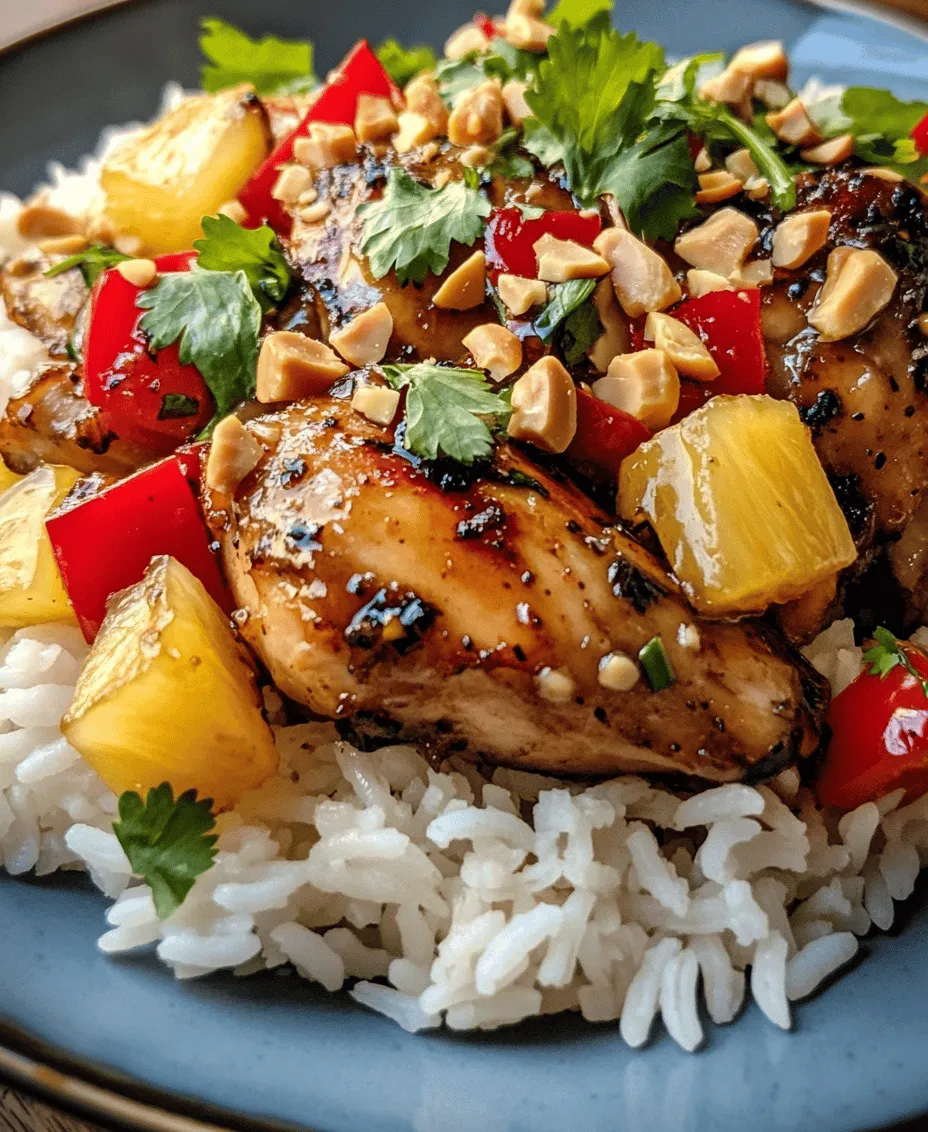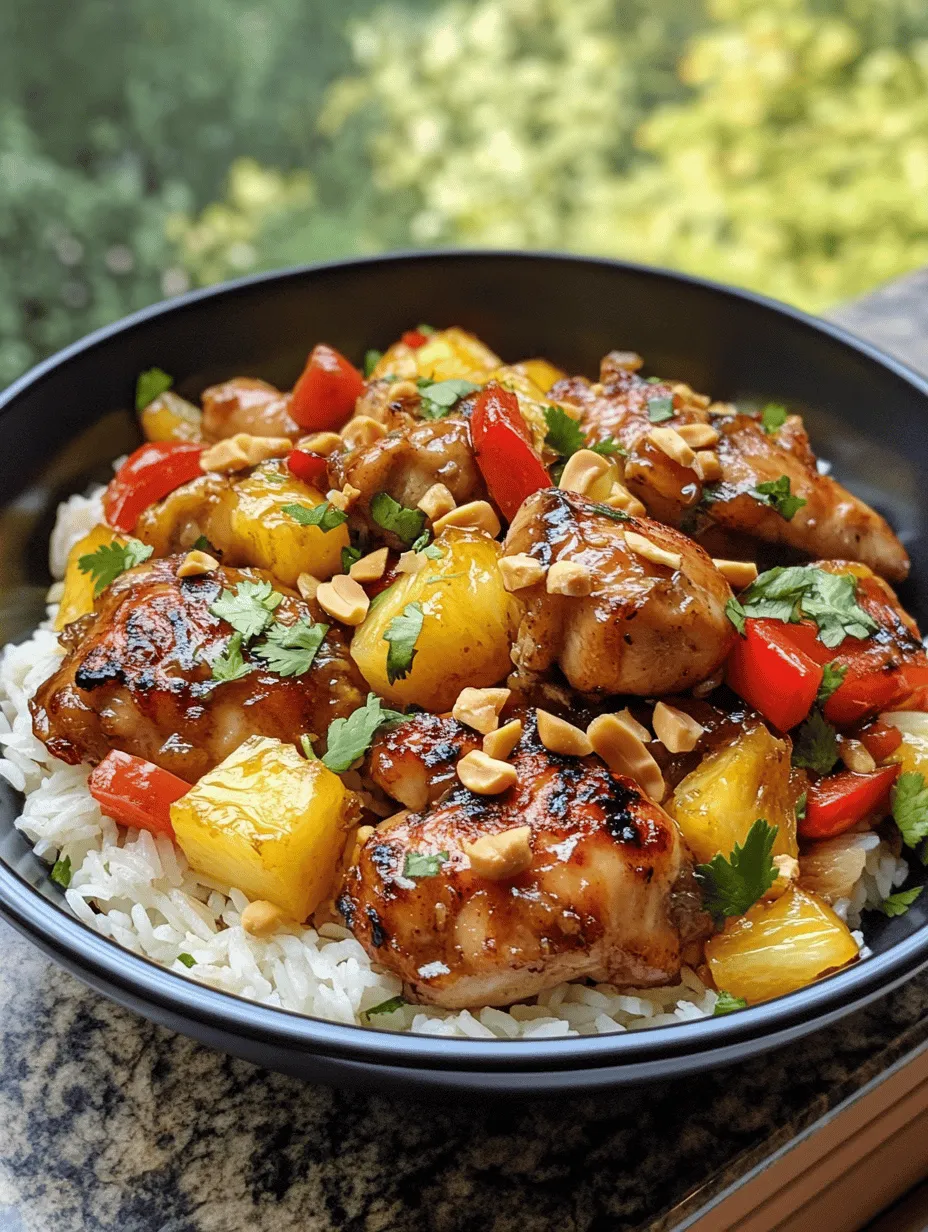Introduction to Sweet and Spicy Thai Chicken
Thai cuisine is a vibrant tapestry of flavors, textures, and aromas that have captivated food lovers around the globe. Renowned for its harmonious balance of sweet, spicy, salty, and sour notes, Thai food presents a culinary experience that is both refreshing and satisfying. One dish that beautifully embodies this complexity is Sweet and Spicy Thai Chicken. This delectable recipe combines tender chicken thighs with a medley of fresh ingredients and zesty sauces, resulting in a dish that excites the palate.
The Sweet and Spicy Thai Chicken recipe is an excellent choice for anyone looking to explore the authentic flavors of Thailand from the comfort of their own kitchen. The beauty of this dish lies in its ability to balance contrasting tastes: the sweetness from pineapple, the heat from Sriracha, and the savory umami of soy and fish sauces come together to create a mouthwatering experience. Each bite delivers a burst of flavor, making it an ideal centerpiece for family dinners or casual gatherings.
When preparing Sweet and Spicy Thai Chicken, the importance of using fresh ingredients cannot be overstated. Fresh produce not only enhances the dish’s flavor but also contributes to its vibrant presentation. Utilizing high-quality chicken and aromatics will elevate your culinary creation, ensuring that every mouthful is as delicious as it is visually appealing.
Understanding the Key Ingredients
To master the Sweet and Spicy Thai Chicken recipe, it’s essential to understand the key ingredients that contribute to its signature flavor profile.
Chicken Thighs: A Flavorful Base
At the heart of this dish are chicken thighs, which are favored for their rich flavor and juicy texture. Unlike chicken breasts, which can dry out easily, thighs remain tender and moist during cooking, resulting in a more succulent meal. Their higher fat content also allows them to absorb the marinade and sauces more effectively, making every bite burst with flavor.
Fresh Aromatics: Garlic and Ginger
No Thai dish is complete without the aromatic foundation of garlic and ginger. These two ingredients are staples in Thai cooking and serve to infuse the chicken with layers of flavor. Garlic adds a robust, pungent note, while ginger introduces a warm, slightly spicy undertone that enhances the overall taste. Using fresh garlic and ginger, rather than powdered alternatives, ensures that their distinct flavors shine through in the finished dish.
Vibrant Vegetables: Red Bell Pepper and Pineapple
To add color and texture to the dish, we incorporate red bell peppers and pineapple. The sweet crunch of red bell pepper not only complements the savory elements but also provides a pleasing contrast in both flavor and texture. Pineapple, with its juicy sweetness, plays a dual role in this recipe; it works as both a flavor enhancer and a natural meat tenderizer due to its bromelain content. This tropical fruit balances the heat of the dish, making it more approachable for those who might shy away from spiciness.
Key Sauces: Soy Sauce and Fish Sauce
The savory depth of Sweet and Spicy Thai Chicken is achieved through the use of key sauces, specifically soy sauce and fish sauce. Soy sauce, a staple in many Asian cuisines, contributes a rich umami flavor that forms the backbone of the dish’s sauce. Fish sauce, on the other hand, introduces a unique, briny depth that enhances the overall flavor profile. Together, they create a savory base that elevates the chicken and vegetables.
Sweetness and Heat: Sugar and Sriracha
A crucial aspect of the Sweet and Spicy Thai Chicken is the balance between sweetness and heat. Granulated sugar or brown sugar is often added to the sauce to enhance the sweetness, which is essential in Thai cuisine. This sweetness counteracts the heat from Sriracha, a popular Thai chili sauce known for its bold flavor and spice. The interplay of sugar and Sriracha creates a well-rounded sauce that tantalizes the taste buds.
The Brightness of Lime Juice
To add a refreshing acidity, lime juice is incorporated into the mix. This tangy element is vital in balancing the richness of the chicken and the sweetness from the pineapple and sugar. A squeeze of fresh lime juice not only brightens the dish but also enhances the overall flavor, making it more vibrant and appealing.
Cornstarch: For Sauce Thickening
Finally, cornstarch plays a crucial role in achieving the desired consistency of the sauce. When mixed with water and added to the cooking process, cornstarch thickens the sauce, allowing it to cling to the chicken and vegetables. This ensures that every bite is loaded with flavor, making the dish more satisfying and enjoyable.
Marinating the Chicken: A Crucial Step
One of the most important steps in preparing Sweet and Spicy Thai Chicken is marinating the chicken. Marinating not only infuses the meat with flavor but also helps to tenderize it, resulting in a juicier and more flavorful dish.
Importance of Marinating for Flavor Development
Marinating the chicken allows the flavors from the marinade—comprised of soy sauce, fish sauce, garlic, ginger, and other spices—to penetrate the meat. This step is crucial as it provides a depth of flavor that cannot be achieved through simple seasoning during cooking. The longer the chicken marinates, the more pronounced the flavors will become, leading to a more delicious final product.
How to Marinate Chicken Effectively
To marinate the chicken effectively, start by cutting the chicken thighs into bite-sized pieces. This increases the surface area, allowing the marinade to coat the meat evenly. In a bowl, combine the marinade ingredients: soy sauce, fish sauce, minced garlic, grated ginger, sugar, and a dash of Sriracha. Mix well to ensure that the sugar dissolves completely.
Once the marinade is ready, add the chicken pieces to the bowl, making sure they are fully submerged in the mixture. For best results, cover the bowl with plastic wrap or transfer the chicken and marinade to a resealable plastic bag, pressing out any excess air. Allow the chicken to marinate in the refrigerator for at least 30 minutes, though marinating for several hours or overnight will yield even better results.
Suggested Marination Time and Tips for Best Results
While 30 minutes will suffice for flavor infusion, aim for a minimum of 2 hours for optimal flavor development. If time allows, marinating overnight is ideal. Just be cautious not to exceed 24 hours, as the acidity in the marinade can start to break down the chicken too much, resulting in a mushy texture.
Adjusting the spice levels during marination is also key for personal preference. If you enjoy a spicier dish, consider adding more Sriracha to the marinade or incorporating sliced fresh chilies. For those who prefer a milder flavor, feel free to reduce the amount of Sriracha or omit it altogether.
Cooking Techniques for Perfect Chicken
Once the chicken has marinated to perfection, the next step is cooking it using the right techniques to ensure it remains juicy and flavorful.
Stir-Frying vs. Sautéing
When it comes to cooking methods, stir-frying is the preferred technique for this recipe. This method involves quickly cooking the chicken over high heat while continuously stirring. This not only ensures even cooking but also helps to lock in moisture and flavor. Alternatively, sautéing can also be used, which involves cooking the chicken in a small amount of oil over medium-high heat. While both methods can yield delicious results, stir-frying is ideal for achieving that authentic Thai flavor and texture.
Temperature Matters
Using the right temperature is crucial for cooking chicken effectively. For stir-frying, preheat your wok or skillet until it is very hot before adding the oil. A hot cooking surface will create a sear on the chicken, locking in juices and flavor while preventing sticking. You should also avoid overcrowding the pan, as this can lower the temperature and lead to steaming rather than searing.
Achieving Golden Brown Texture
To achieve a beautiful golden brown texture on your chicken, ensure that the pieces are spaced apart in the pan. Allow them to sear on one side before flipping them over. This not only enhances the visual appeal of the dish but also adds a rich, flavorful crust that contrasts beautifully with the tender meat.
By following these steps, you can create a mouthwatering Sweet and Spicy Thai Chicken dish that showcases the vibrant flavors of Thai cuisine. The combination of fresh ingredients, a well-balanced marinade, and proper cooking techniques will result in a dish that is sure to impress both family and friends. Stay tuned for the next part of this article, where we will dive deeper into the cooking process and share tips for serving and pairing this delicious meal.

Cooking chicken thoroughly while retaining juiciness is essential for achieving the perfect texture and flavor in any dish. When preparing Sweet and Spicy Thai Chicken, it’s crucial not only to ensure that the chicken is cooked to the correct internal temperature but also to maintain its moisture. This is best achieved by using chicken thighs, which are inherently juicier than breasts and help create a rich, flavorful experience. As you embark on this culinary journey, follow the steps outlined below to create a dish that is sure to impress.
Creating the Flavorful Sauce
Steps to Sauté Aromatics and Why Timing is Crucial
The sauce is the heart of Sweet and Spicy Thai Chicken, and it begins with the aromatics. Start by heating a tablespoon of oil in your skillet over medium heat. Add minced garlic and ginger, cooking for about 30 seconds until they become fragrant. Timing is crucial here; if you allow them to brown too much, they could turn bitter, negatively impacting the overall flavor of your dish.
Following the garlic and ginger, you can introduce chopped onions, cooking them until they become translucent. This step not only builds flavor but also adds a sweetness that balances the dish’s heat. Once your aromatics are ready, it’s time to add the key ingredients that bring the sauce to life.
How to Incorporate Vegetables for Texture and Flavor
For added texture and flavor, consider incorporating bell peppers, snap peas, or carrots into your sauté. Slice these vegetables thinly to ensure they cook evenly and quickly. Add them to the pan after the onions have softened, allowing them to sauté for about 2-3 minutes until they just start to soften. This not only adds color to your dish but also contributes essential nutrients and a satisfying crunch.
Techniques for Combining Ingredients to Create a Cohesive Dish
Once your vegetables have sautéed, it’s time to add the liquids that will form the base of your sauce. Combine soy sauce, fish sauce, honey, and lime juice in a bowl, mixing them well. Pour this mixture over the sautéed aromatics and vegetables in the skillet, stirring to ensure everything is well-coated. The key to achieving a cohesive dish is not just in the mixing but also in allowing the ingredients to come together harmoniously.
Stirring continuously for about 1-2 minutes ensures that the flavors meld beautifully. You’ll notice the aroma filling your kitchen, a delightful prelude to the flavors that will soon dance on your palate.
Explanation of Simmering and Its Role in Flavor Melding
After combining the ingredients, bring the mixture to a gentle simmer. Simmering allows the flavors to meld and develop more complexity. Maintain a low simmer for about 5-7 minutes. This process thickens the sauce slightly and infuses the chicken with deep flavors when you add it to the pan.
Thickening the Sauce: Achieving the Right Consistency
Importance of Sauce Thickness in Asian-Inspired Dishes
In Asian-inspired dishes, the thickness of the sauce is crucial. A well-thickened sauce clings beautifully to the chicken and vegetables, ensuring every bite is packed with flavor. The right consistency enhances the overall eating experience, making each mouthful satisfying and enjoyable.
Step-by-Step Guide on Using Cornstarch for Thickening
To thicken your sauce, you’ll want to utilize cornstarch. Begin by creating a slurry: in a small bowl, combine two tablespoons of cornstarch with two tablespoons of cold water, stirring until smooth. Slowly pour this mixture into the simmering sauce while whisking continuously. This technique prevents lumps from forming and ensures a silky texture.
Continue to stir as the sauce thickens, which should take about 2-3 minutes. You want it to reach a consistency that coats the back of a spoon without being overly gloopy. If the sauce becomes too thick, a splash of chicken broth or water can help you reach the desired consistency.
Tips for Ensuring the Sauce Clings Well to the Chicken and Vegetables
To ensure the sauce adheres well to the chicken and vegetables, make sure everything is well-coated before serving. Toss the chicken pieces in the sauce for a minute or so before plating to ensure they absorb the flavors. Additionally, allowing the dish to rest for a few minutes before serving can help the sauce settle and stick better.
Serving Suggestions for Sweet and Spicy Thai Chicken
Recommendations for Garnishes: Cilantro and Chopped Peanuts
Garnishing your Sweet and Spicy Thai Chicken is the final touch that elevates the dish. Fresh cilantro adds a burst of freshness and a pop of color, while chopped peanuts provide a delightful crunch that complements the tender chicken. Sprinkle these garnishes generously just before serving to enhance both the visual appeal and flavor profile.
Ideal Accompaniments: Jasmine Rice and Its Significance
This dish pairs beautifully with jasmine rice, which is an integral component of many Thai meals. The fragrant rice absorbs the flavorful sauce, balancing the sweetness and spice with its neutral taste. To prepare jasmine rice, rinse the grains under cold water until the water runs clear, then cook according to package instructions. The fluffy texture of jasmine rice makes it the perfect companion for your Sweet and Spicy Thai Chicken.
Presentation Tips for an Appealing Dish
Presentation plays a crucial role in making your meal inviting. Serve the Sweet and Spicy Thai Chicken in a large bowl or on a platter, garnishing it with cilantro and peanuts. You can also add lime wedges on the side for those who want an extra zing of acidity. Consider serving the rice in a separate dish or on the side, allowing guests to serve themselves and enjoy the dish at their own pace.
Alternative Serving Ideas for Variety
For those looking to switch things up, consider serving the Sweet and Spicy Thai Chicken in lettuce wraps for a light and refreshing meal. Simply use large lettuce leaves as a wrap and fill them with the chicken, sauce, and vegetables. This alternative not only offers a fun way to eat but also adds a crunchy texture that contrasts wonderfully with the tender chicken.
Nutritional Benefits of Sweet and Spicy Thai Chicken
Overview of the Nutritional Aspects of the Ingredients
Sweet and Spicy Thai Chicken is not just a delight for the taste buds, but it also packs a nutritional punch. Chicken thighs provide a good source of protein, which is essential for muscle repair and growth, and they contain important vitamins and minerals, including B vitamins and iron. The vegetables in this dish add a variety of nutrients, including fiber, vitamins A and C, and antioxidants, making it a well-rounded meal.
Health Benefits of Chicken Thighs Versus Other Cuts
Using chicken thighs in this recipe offers several benefits over other cuts. They are juicier and more flavorful, which enhances the overall taste of the dish. Additionally, chicken thighs have a slightly higher fat content, which can help you feel fuller for longer, making it a satisfying meal choice.
Nutritional Value of Vegetables and Fruits Used in the Recipe
The addition of vegetables like bell peppers and snap peas not only enhances the dish’s flavor but also boosts its nutritional value. Bell peppers, for example, are high in vitamin C, which is important for immune function, while snap peas provide dietary fiber that aids digestion. The lime juice used in the sauce adds a dose of vitamin C as well, contributing to the dish’s overall health benefits.
Balancing Flavors While Considering Dietary Needs
When preparing Sweet and Spicy Thai Chicken, consider your dietary needs. You can easily adjust the sweetness or spiciness according to your preferences. For a lower-sugar option, reduce the honey or substitute it with a natural sweetener. To accommodate gluten-free diets, opt for tamari instead of soy sauce. This dish is versatile and can be adjusted to suit various dietary requirements without compromising on taste.
Conclusion: Embracing Thai Flavors at Home
In summary, Sweet and Spicy Thai Chicken is a vibrant dish that encapsulates the essence of Thai cuisine. With its harmonious blend of sweet, spicy, and savory flavors, it exemplifies the culinary artistry that Thai dishes are known for. The preparation process, from sautéing the aromatics to thickening the sauce, ensures that every component works together to create a delightful meal.
We encourage you to explore the world of Thai cuisine further, embracing the diverse and dynamic flavors it offers. Cooking is not just about preparing meals; it’s about sharing experiences and creating memories with family and friends. So gather your loved ones, whip up this delicious dish, and enjoy the joy of cooking together. Whether it’s a weeknight dinner or a special occasion, Sweet and Spicy Thai Chicken is sure to impress and satisfy every palate.



